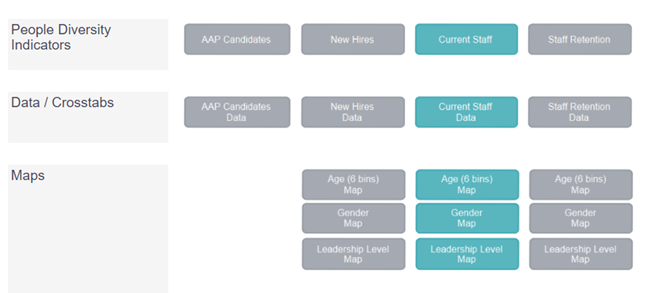Is your organization on a diversity, equity, and inclusion (DEI) journey too?
Eighty-five percent of respondents to the BRIDGE survey, the first sector-wide DEI baseline survey of US-based development and humanitarian organizations, indicated that their organizations were implementing a DEI initiative at the time of the survey. It’s been almost a year since the results were released and, here at PATH, we have made incredible strides both in our vision and strategy, now led by our new DEI Director, Levis Nderitu.
One major milestone in Q4 of 2021 was the launch of our PATH People Diversity Dashboard to help PATH staff achieve the goal, as set out in the PATH DEI Strategy, of diversifying PATH staff at all levels with clear objectives for the Board, Executive Team, PATH Leadership Team, and people managers. By bringing more transparency to staff and leaders, we can better understand gaps and challenges and celebrate our milestones against our DEI goals.

During our requirements gathering for this effort, we first encountered the question, “What is transparent?” when determining what DEI dimensions to share. Like many organizations, we collect Age and Gender globally but only collect Race/Ethnicity, Disability Status, and Veteran Status for our US-based employees. Our organization was hungry for this information, but we struggled with what the most equitable approach was. Should we make all data available? Aggregate information only? Why should those in one region have more access to diversity information when the collection hasn’t yet evolved for the entire organization?
Secondly, we had to determine how to balance our organizational need for visibility with preserving data confidentiality for individual employees. How do we protect privacy when some dimensions have only one or two people in them?
After engaging the Humentum Connect community and our Monitoring and Evaluation team for best practices, we decided that the data should be blinded (or masked). Values less than five would be systematically replaced with an alternative character so that individual people could not be identified based on their known characteristics.
If only one category has fewer than five individuals, we decided the next-largest category should also be blinded to prevent the derivation of small numbers. As our DEI data landscape evolves, we will revisit this number and approach to ensure we balance transparency with privacy.
After our blinding method was finalized, and just days before launching our dashboard, the design team received feedback that the blinded DEI data for our Executive Team (only nine members) was not useful in measuring against our DEI goals of diversifying at all levels of the organization. The Executive Team are highly visible members of the organization who have personal information disclosed on our annual report. So, we had to ask the question, “Do the same expectations of privacy apply if this data is already published and available?” We debated, and we finally landed on no. Because our Executive Team already discloses this information publicly, we chose to incorporate it in full within our people dashboard.
Our DEI data collection, configuration, and goals for more transparency are evolving and we are ready to take the next steps with this discussion. And that is where we think you can come in.
Are you challenged by questions and decisions around collecting, sharing, and ensuring what you share are driven by business decisions rather than transparency for the sake of transparency?
If you are an HR or DEI professional charged with answering these types of questions and guiding DEI data efforts forward, we invite you to catch up on the recording of our HR Roundtable from March, where we had a lively and focused conversation on the topic.
Some questions we explored:
- What does transparency look like for your organization?
- How are you sharing DEI data with your organization? Do you have a process for people requesting DEI data? What is it?
- We can capture nonbinary gender data by these categories, but the US Equal Employment Opportunity Commission compliance reporting still requires us to use Male/Female. How would we adhere to the compliance reporting while allowing us to capture the “true” state?
- How do you define race and ethnicity outside of the United States?
- What have you learned through your journey? What challenges have you and your team faced?
PATH’s HR colleagues shared more details on our decisions and what is on our horizon.

